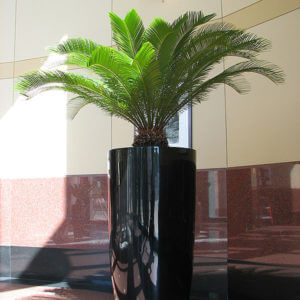What is that Palm-like Plant?

Bamboo Palms in the Reagan Oval Office.
The palm is an interior design classic, versatile and widely utilized to adorn spaces ranging from plush stately parlors to slick corporate office lobbies. This botanical family of plants are known for their fronds, trunks and stems. There are many plants that resemble palms—some of them even have the term “palm” in their name, but they may not be palms at all. We’ve put a list together to help you identify which plants are palms, which are not and how you can tell the difference.
INDEED, a Palm!
- Adonidia Palm: This is the quintessential palm for tropical themed décor. The showy palm has smooth trunk and the foliage is glossy and arched with a feather-like appearance. These palms give off a classic Florida vibe commonly grown in groups of two or three. These palms require high light.
- Areca Palm: The classic shape of the Areca makes it one of the most popular palms sold in garden centers. Its feathery, arching fronds are often confused with the more durable and more expensive Kentia Palm. The Areca Palm can do well indoors but is not a favorite among interior plantscape maintenance professionals. It is prone to leaf spots and mites.
- Majesty Palm: This plant the most common palms sold in the USA. It has a classic palm shape and when presented as a houseplant, it is often confused with the more expensive Kentia Palm. The Majesty Palm is a high light and typically low cost plant, making it a sensible choice for outdoor summer patios or decorating for a special event. However, the Majesty Palm is not recommended as an indoor houseplant. These palms are often not acclimated for indoor use. When placed indoors, the palms weaken and are susceptible to pests.
- Kentia Palm: The most elegant and graceful of all palms used in interior design. This classic palm is culturally iconic thanks to its appearance on Hollywood sets. It is used to decorate some of the most elegant hospitality interiors around the world. Native to Lord Howe Island, most of the Kentias in the United States are grown in Hawaii. The Kentia is shade-grown and slow growing, making it hardy for interiors but also more expensive. Large Kentia palms are adored for their longevity and may only be procured from a professional interior landscape provider.
- Bamboo Palm: Also known as a Chamaedorea plam, the bamboo palm is in fact a palm and is often confused with bamboo because of its common name, Bamboo. The slim trunks are grown in clusters similar to bamboo. Each frond on this plant has between 10-14 feathery leaflets, which can resemble bamboo shoots. The palms have famously adorned the Oval Office at the White House in Washington DC. A tried and true office plant among interior landscape professionals, the Bamboo Palm is more resilient than the Areca Palm and less expensive than the Kentia Palm
- Rhapis Palm: Commonly referred to as the lady palm, this multi-stemmed plant has glossy leaves. Its leaf ends are jagged and its stems are covered in a dark brown fiber that appears woven. Hawaiian-grown Rhapis palms are elegant and columnar in form. This palm is a favorite in hotel lobbies and is popular with interior landscape designers because of its hardiness and beauty.
- Pygmy Date Palm: While this palm is related to the famous fruit-producing Date Palms of the Middle East, the Pygmy Date Palm - also known as the Phoenix Roebelenii - is grown for its ornamental foliage. Native to southeast Asia, the Pygmy Date Palm grows 4 to 12 feet tall and can be identified by its thick trunk, and crown of wispy palm frond leaves. Don’t expect date fruit from this palm, though. Indoor environments rarely have enough light to support reproduction. When it does fruit, it shows seeds with only a thin casing of fruit.
- European Fan Palm: This elegant palm has long, fan-like leaves that come in shades of green, blue, silver and yellow. The trunks on the European Fan Palm have a scale-like texture and can grow up to 15 feet in height.
NOT a Palm!
- Sago Palm: Commonly mistaken as a mini palm tree, it’s actually not a palm at all! The Sago Palm is a member of the cycad family, where feather-like leaves grow directly from their thick trunks.
- Ponytail Palm: Just like its name, the Ponytail Palm has long, curly leaves that grow from the top of the trunk, resembling a ponytail. These have bulbs at the base of the trunk that are used to store water, which is also why this plant is called the Elephant’s Foot Palm. This plant is not a palm or a tree, but a part of the Agave family.
- Banana Palm: Easily recognized by their large, ribbed leaves, the Banana Palm produces the fruit of their name — bananas! While this plant visually looks like a palm, it’s a member of the Musa family. It’s a fast-growing plant and has a bundled collection of leave stalks at its base, rather than a trunk.
- Bird of Paradise: A favorite plant for residential and commercial interiors, the Bird of Paradise can be identified by its banana-shaped leaf. It is often mistaken for a Banana Palm. The white Bird of Paradise is commonly utilized as an office plant in lobbies or building entrances.
- Yucca Plant: Another plant of the Agave family, the Yucca Plant grows on canes or large, woody stems. Large Yuccas have clear trunks and thick blade-lake leaves, which is why they are often confused with palms.
- Dracena Arborea: These unique plants are a part of the Draceana family and are used in trendy home or office settings to achieve a unique Biophilic design. This plant can be identified by its spiky leaves which form at the top of the trunk. There are a few different varieties of the Dracena Arborea. Some grow in tree form while others grow in bush form.
Speak with a Planterra expert today.
Pages: 1 2



